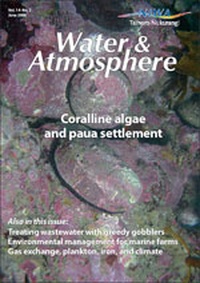Connecting habitats in estuaries
Low tide reveals the traps for sampling animals within the seagrass. (Click for detail.) (Photo: Carolyn Lundquist)
Current profilers are positioned to measure near-bed currents inside and outside the seagrass bed. (Photo: Carolyn Lundquist)
As local communities and management agencies set out to restore New Zealand estuaries, Carolyn Lundquist, Judi Hewitt, and Conrad Pilditch are looking for ways to ensure they succeed.
Estuaries in New Zealand are composed of many different habitat types, including unvegetated habitats like sand and mudflats, and vegetated habitats like mangroves and seagrass. Human-induced disturbances, such as sediments washed down from residential development, can affect animals living within the estuary and change the relative proportions of different habitat types. For example, seagrass habitats have declined in estuaries throughout the North Island, while mangrove coverage has increased in the upper reaches of many estuaries. We must understand how these different habitat types are connected in order to predict how changes in their distribution might affect recovery in our estuaries. Realising that restoration is more complicated than merely planting seagrass or transplanting shellfish, we are looking at the natural processes that determine colonisation of habitats in estuaries.
Recolonisation in estuaries
The animals that live in the sediments within vegetated habitats like seagrass and mangroves are the same as those living in nearby unvegetated sand and mudflat habitats. Colonisation depends in part on organisms – often in the larval or juvenile stages – being moved around the estuary by water currents. However, colonisation rates differ between habitats within estuaries. Using hydrodynamic models, NIWA scientists have shown that transport of organisms within estuaries (and thus the likelihood of recolonisation after a disturbance) is more limited than was previously thought. For example, tidal creeks, often protected from wind and waves, are much less likely to be recolonised than exposed sandflats. As we learn more about the recovery processes in estuaries, we also need to understand how vegetation affects the transport of organisms, and how the mosaic of habitat types within estuaries functions together.
Do seagrass meadows affect the transport of organisms?
Vegetation, like other physical structures in the ocean, can modify the effects of tidal currents and waves on the sediment. For example, seagrass blades may change the water flow above the seagrass meadow, making it more difficult for larval or juvenile animals to be transported into the seagrass and settle. Alternatively, the blades may act as a filter, capturing all organisms that pass by. To find out which result is more likely, we looked at transport around seagrass beds to see if there were differences in tidal currents and turbulence created by seagrass blades that influenced colonisation.
We conducted a field experiment in Whangapoua seagrass meadows, looking at differences at sites inside and outside the beds, and at the patchy boundary area at the edge of the bed. We used sediment traps to investigate differences in the animals that are available to colonise these different locations. The animals they catch include larval crabs and barnacles, juvenile shellfish, marine worms, adult crabs, and sea snails. Our traps were located at different heights above the seafloor to compare differences in how animals are moving in the water. Water column traps catch animals that float in the water, while bedload traps catch animals that crawl on the seafloor or are rolled along by waves or tidal currents. This distinction is important because the strategy by which each animal moves is related to how far it travels; for example, animals that crawl do not move as far as those that float in the water.
To investigate physical differences inside and outside seagrass beds, we measured tidal currents at different heights above the seafloor, and used wave-pressure gauges to measure water depth, wave height, and the amount of sediment particles in the water. Coupling the physical and biological data allows us to see if there are differences in transport, and to determine the mechanism behind these differences.
Our preliminary results show that flows near the seafloor are much reduced within seagrass meadows compared to unvegetated seafloor areas. Our trap data indicate that traps in seagrass habitats collect fewer juvenile shellfish and other colonising animals than traps in unvegetated habitats, implying that transport may be a limiting factor in the recolonisation of animals in seagrass habitats. In terms of understanding connections between habitat types within estuaries, it seems that vegetation, in addition to variation in tidal currents and exposure to waves, results in differences in the ability of estuarine habitats to be recolonised after disturbances. Our understanding of the relationship between organism transport and physical structure within seagrass beds will also enhance our knowledge of transport processes between coastal habitat types in larger-scale estuarine restoration projects.
Why New Zealand species are important
In other parts of the world, seagrass beds support highly diverse communities that differ from unvegetated habitats in species abundance and composition. We often hear about lush, extensive subtidal seagrass meadows, in tropical and temperate parts of the world, which support high abundances of juvenile fish and invertebrates. In contrast, New Zealand seagrass habitat is primarily intertidal, has much shorter blades, and is much patchier. Our seagrass meadows have similar species of animals living within the sediment and, as they are mostly intertidal, they do not support permanent fish communities.
When we look at New Zealand estuaries, we must not over-generalise from other parts of the world. By continuing to examine the connections that are specific to New Zealand estuarine habitat types, we can begin to understand how human disturbances will change our estuaries, and how changes in distributions of seagrass and mangroves might affect the animals that live within them.
Teachers’ resource for NCEA AS: Biology 90483 (2.9), 90460 (2.4). See other curriculum connections at www.niwa.co.nz/pubs/wa/resources





